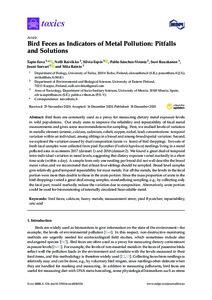Bird Feces as Indicators of Metal Pollution: Pitfalls and Solutions
Espin S; Sorvari J; Ruuskanen S; P Sánchez-Virosta; Raivikko N; Eeva T; Rainio M
Bird Feces as Indicators of Metal Pollution: Pitfalls and Solutions
Espin S
Sorvari J
Ruuskanen S
P Sánchez-Virosta
Raivikko N
Eeva T
Rainio M
MDPI AG
Julkaisun pysyvä osoite on:
https://urn.fi/URN:NBN:fi-fe2021042826551
https://urn.fi/URN:NBN:fi-fe2021042826551
Tiivistelmä
Bird feces are commonly used as a proxy for measuring dietary metal exposure levels in wild populations. Our study aims to improve the reliability and repeatability of fecal metal measurements and gives some recommendations for sampling. First, we studied levels of variation in metallic element (arsenic, calcium, cadmium, cobalt, copper, nickel, lead) concentrations: temporal variation within an individual, among siblings in a brood and among-brood/spatial variation. Second, we explored the variation caused by dual composition (urate vs. feces) of bird droppings. Two sets of fresh fecal samples were collected from pied flycatcher (Ficedula hypoleuca) nestlings living in a metal polluted area in summers 2017 (dataset 1) and 2018 (dataset 2). We found a great deal of temporal intra-individual variation in metal levels, suggesting that dietary exposure varied markedly in a short time scale (within a day). A sample from only one nestling per brood did not well describe the brood mean value, and we recommend that at least four siblings should be sampled. Brood level samples give relatively good temporal repeatability for most metals. For all the metals, the levels in the fecal portion were more than double to those in the urate portion. Since the mass proportion of urate in the bird droppings varied a great deal among samples, standardizing sampling, e.g., by collecting only the fecal part, would markedly reduce the variation due to composition. Alternatively, urate portion could be used for biomonitoring of internally circulated bioavailable metal. View Full-Text
Keywords: bird feces; calcium; heavy metals; measurement error; pied flycatcher; repeatability; uric acid
Kokoelmat
- Rinnakkaistallenteet [19207]
